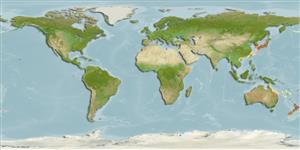Echinoidea |
Camarodonta |
Echinometridae
Environment: milieu / climate zone / गहराई सीमा / distribution range
पारिस्थितिकी
. Subtropical
Western Pacific.
Length at first maturity / आकार / Weight / Age
परिपक्व अवधि: Lm ? range ? - ? cm
Found on shallow reefs (Ref. 106682).
Life cycle and mating behavior
परिपक्व अवधि | पुनरुत्पत्ति | मछलीऔ का अंडे देना | Eggs | Fecundity | Larvae
Members of the class Echinoidea are gonochoric. Fertilization is external. Brooding is common, eggs are held either on the peristome, around the periproct or deep into the concavities on the petaloids. Life cycle: Embryos develop into planktotrophic larvae (echinoplateus) and live for several months before they sink to the bottom using their tube feet to adhere on the ground where they metamorphose into young urchins.
Gardner, J.P.A., M.J. Curwen, J. Long, R.J. Williamson and A.R. Wood 2006 Benthic community structure and water column characteristics at two sites in the Kermadec Islands Marine Reserve, New Zealand. New Zealand Journal of Marine and Freshwater Research 40:179-194. (संदर्भ 88938)
IUCN Red List Status
(संदर्भ 130435: Version 2025-1)
CITES status (संदर्भ 108899)
Not Evaluated
CMS (संदर्भ 116361)
Not Evaluated
Threat to humans
Harmless
Human uses
| FishSource |
साधन
अधिक जानकारी
Trophic EcologyFood items (preys)
संघटक आहार
आहार खपत
परभक्षी
Life cycleपुनरुत्पत्तिपरिपक्व अवधिFecundityमछलीऔ का अंडे देनाEggsEgg developmentLarvae PhysiologyOxygen consumption
Human RelatedStamps, coins, misc.
इंटरनेट स्रोत
Estimates based on models
Preferred temperature
(Ref.
115969): 17.9 - 24.2, mean 20.3 (based on 77 cells).
